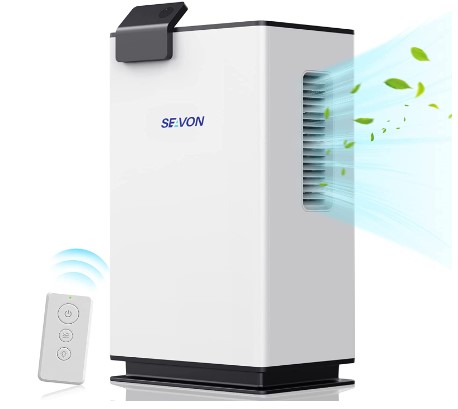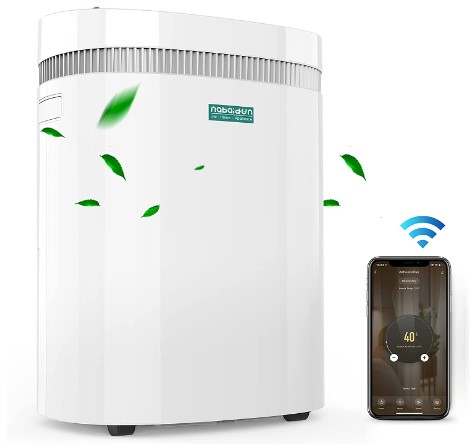We may receive a small commission for qualifying purchases made from the product links in this post at no additional cost to you.
Excess humidity can make your room musty, stuffy, and damp. Having a dehumidifier or using the ventilation in your home to get rid of the excess moisture will ensure that you live in a comfortable environment.
Dehumidifiers are great for sucking out excess moisture in a room. They can be used at home or commercially. If you live in a place with high humidity levels, using a dehumidifier can greatly improve your air quality.
Dehumidifiers can be placed on a carpet provided that the position of the dehumidifier is central, in relation to the furniture, the walls, and any other big appliances in your room. Placing a dehumidifier in a congested area will reduce its efficiency and limit its ability to absorb excess moisture from its surroundings because of the reduced air circulation in the room.
Placing a dehumidifier on a carpet can have its benefits and potential risks. This article will shed some light on the benefits and risks of placing a dehumidifier on a carpet and hopefully help you make an informed decision about where to place your dehumidifier.
This post addresses the following topics:
- Can a dehumidifier be placed on a carpet?
- Where should your dehumidifier be placed?
- How do you dry a carpet with a dehumidifier?
Can a Dehumidifier be Placed on Carpet?
Yes, you can place a dehumidifier on a carpet. While dehumidifiers are great for removing excess moisture from the air in your home, they can also draw out excess moisture from your carpet or the furniture in your home.
If your carpet is centrally placed in your home, you can opt to place the dehumidifier on the carpet or on a raised surface like a table to ensure that the dehumidifier can easily draw in moisture from the air in your home.

Considerations for Placing Your Dehumidifier on a Carpet: Where Should A Humidifier be Placed?
If you want to get the best performance when using your dehumidifier, you should consider the following factors:
Placement
Your dehumidifier should be placed on a flat surface. Placing the dehumidifier on a surface that is not flat can increase the risks of water spills, especially when the water tank is full or almost full.
If you would wish to place your dehumidifier on your carpet, ensure that you place the dehumidifier on an area that is flat. You can lift the carpet and vacuum the area underneath it to remove any dirt or falling objects that might have rolled under the carpet.
Positioning
You should ensure that you position the dehumidifier at a central location in your room to promote easy air flow and circulation in and out of the dehumidifier.
Placing the dehumidifier near your wall, furniture, or other appliances in your home can reduce the amount of humid air flowing inside the dehumidifier, which would result in a reduced rate of the amount of moisture removed from the room within a specific amount of time.
Tightly Secured Water Tank
Ensure that the lid of the water tank is tightly secured to avoid water spills. One of the dangers of placing any container that has water on your carpet is the risk of water spills.
To avoid these accidents, it is recommended to secure the lid of the water tank well before turning on the dehumidifier.
Empty Water Tank When Full
To avoid any accidents, you should ensure that you empty the water tank immediately after using the dehumidifier or when the water tank is full.
If you plan of leaving the dehumidifier on when you are not at home, ensure that you empty the water tank first to avoid overflowing with excess water.
Most modern dehumidifiers have an automatic shut-off feature that ensures that the dehumidifier switches off after the water tank is full.
This feature reduces the risks of spills and ensures that your furniture, carpet, or wooden floor will not get wet if your dehumidifier gets full while you are not at home.
You can also consider investing in a dehumidifier that can be controlled remotely. This will ensure that you can easily switch the dehumidifier on and off even when you are not near the dehumidifier.
Place the Dehumidifier in a Low Traffic Area
If you plan to place your dehumidifier on your carpet you should ensure that the dehumidifier is not placed in areas with high traffic.
Keeping the dehumidifier in an area with high traffic increases the risks of knocking over the dehumidifier and spilling the water collected in the dehumidifier.
If you want to use the dehumidifier to dry a water spill or dry a specific part of the carpet where there is frequent movement of people, you can reduce the risks of accidents by informing people about the placement of the dehumidifier, and/or keeping pets and children away from that section of the house.
Product Recommendations
If you are looking for a dehumidifier that is easy to use, has remote access control, and auto shut-off features, consider either of the two dehumidifiers mentioned below. You could also use the features of the mentioned dehumidifier to search for alternative options that might suit your home and needs.
Small-Sized Dehumidifier: Seavon Dehumidifier

This is a great small-sized dehumidifier that can be used around the home. It is suitable for small spaces and can be used to dry water spills or remove excess dampness from your carpet.
Features
- Water tank capacity: 68oz (2000 ml)
- Area coverage: 650 sq ft
- Moisture removal: 34oz per day
- Compact
- Portable
- Remote controller
- Has an auto shut-off feature
- Ultra quiet (less than 39dB noise)
- Can be used in your bedroom
- Has 2 working modes
- Working humidity levels: 45% to 90% RH
Pros
- Small-sized and portable
- Comes with a remote control
- Full water tank sensor
- Low-speed and high-speed settings
- 1-year warranty
- Inner power adapter for safety
Con
- Since it is small in size, it might need to be emptied often if you live in a high-humidity area
Large-Sized Dehumidifier: NABAIDUN 50 Pint Dehumidifier
This dehumidifier is a great option for drying wet carpets. It has a specific feature for instant drying that can be used for your laundry. Aside from cases of water spills or dampness, the NABAIDUN dehumidifier can also be used to remove excess humidity in your home.

Features
- Water tank capacity: 1.2 gallons
- Area coverage: 3000 sq ft
- Moisture removal: 50 pints per day
- Working humidity range: 30% to 90% RH
- WIFI app for remote control
- Fan speed control
- Has a timer
- Auto defrost feature
- Universal 360 degrees wheels to move it around
- Built-in handles
- Comes with a draining hose for continuous draining
Pros
- LED touch panel
- Easy to move around (handles and wheels)
- Has a laundry mode for instant drying
- Sleep mode
- Dual draining option (manual and continuous draining)
- Has an auto shut-off feature
Con
- Slightly expensive when compared to small-sized options
How do you dry a carpet with a dehumidifier? (And Other Potential Benefits of Placing a Dehumidifier on a Carpet)
Drying Out Excess Moisture
Placing a dehumidifier on a carpet can help you remove any excess moisture from the carpet and the area around the carpet. As humidity gets in your home, it also accumulates on the furniture and other surfaces in your rooms.
Carpets are no exception. If your home has high humidity levels, placing a dehumidifier on the carpet can offer you the double benefits of sucking out the excess moisture from the carpet while at the same time drawing the excess humidity from the air around your home.
Removal of Dampness after Cleaning Your Carpet
If after cleaning your carpet you suspect that the carpet is not completely dry, you can place a dehumidifier on the carpet to remove the excess moisture in the carpet.
This will fasten the drying process and you will not need to worry about dampness or the unpleasant smell that comes out of damp carpets.
Placing a dehumidifier on your carpet after cleaning your carpet will also ensure that the carpet does not get dirty easily. A damp carpet can easily get dirty when compared to a well-dried carpet. Using a dehumidifier can help you draw out the excess humidity/dampness in the carpet.
Reduce Risk of Mold Growth
Using a dehumidifier to remove any remnants of moisture in the carpet will reduce the risks of mold growth on the carpet or unpleasant odors that might be caused by dampness.
Drying the Carpet after Spot Cleaning

If you do not want to clean your entire carpet because of a spill from food, wine, or anything else that might have dirtied the carpet, you can simply spot clean the area of the carpet that is dirty and then dry the carpet with your dehumidifier.
This is a great way of using your dehumidifier that will ensure that you cut down on the time that you would have spent cleaning your entire carpet.
Drying Water Spills
If you accidentally spill water on your carpet, you can place a dehumidifier near the water spill and let the dehumidifier do its magic. The dehumidifier will absorb the water from the carpet in the same way that it absorbs excess moisture from the air.
This eliminates the need for taking out the carpet to dry it or cleaning the entire carpet. While you could use a wet dry vacuum to do the same task, using a dehumidifier does not require you to do the work yourself but to simply place the dehumidifier near the water spill and let it do its work.
Check Out: Using A Dehumidifier Properly
Final Words
You can place your dehumidifier on your carpet. Dehumidifiers can help you get rid of the musty smell or dampness that might have been caused by the accumulation of humidity in your carpet.
As long as you ensure that the lid on your dehumidifier is tightly secured, you should not have anything to worry about. A dehumidifier can help keep the humidity levels in your home relatively low.
Ensure that you always check the humidity levels in your home before turning on your dehumidifier to avoid lowering the humidity levels in your home past the recommended levels.
